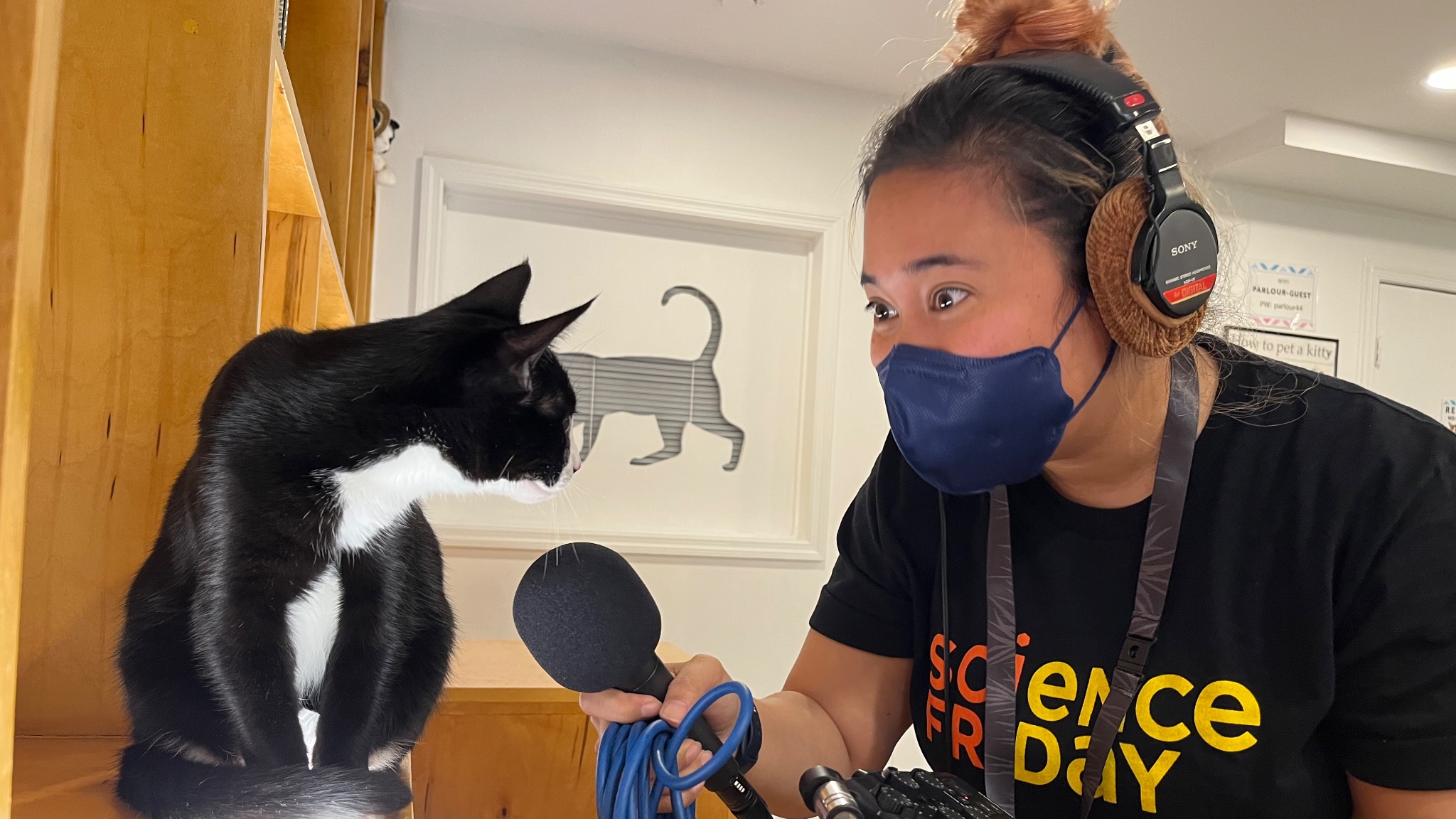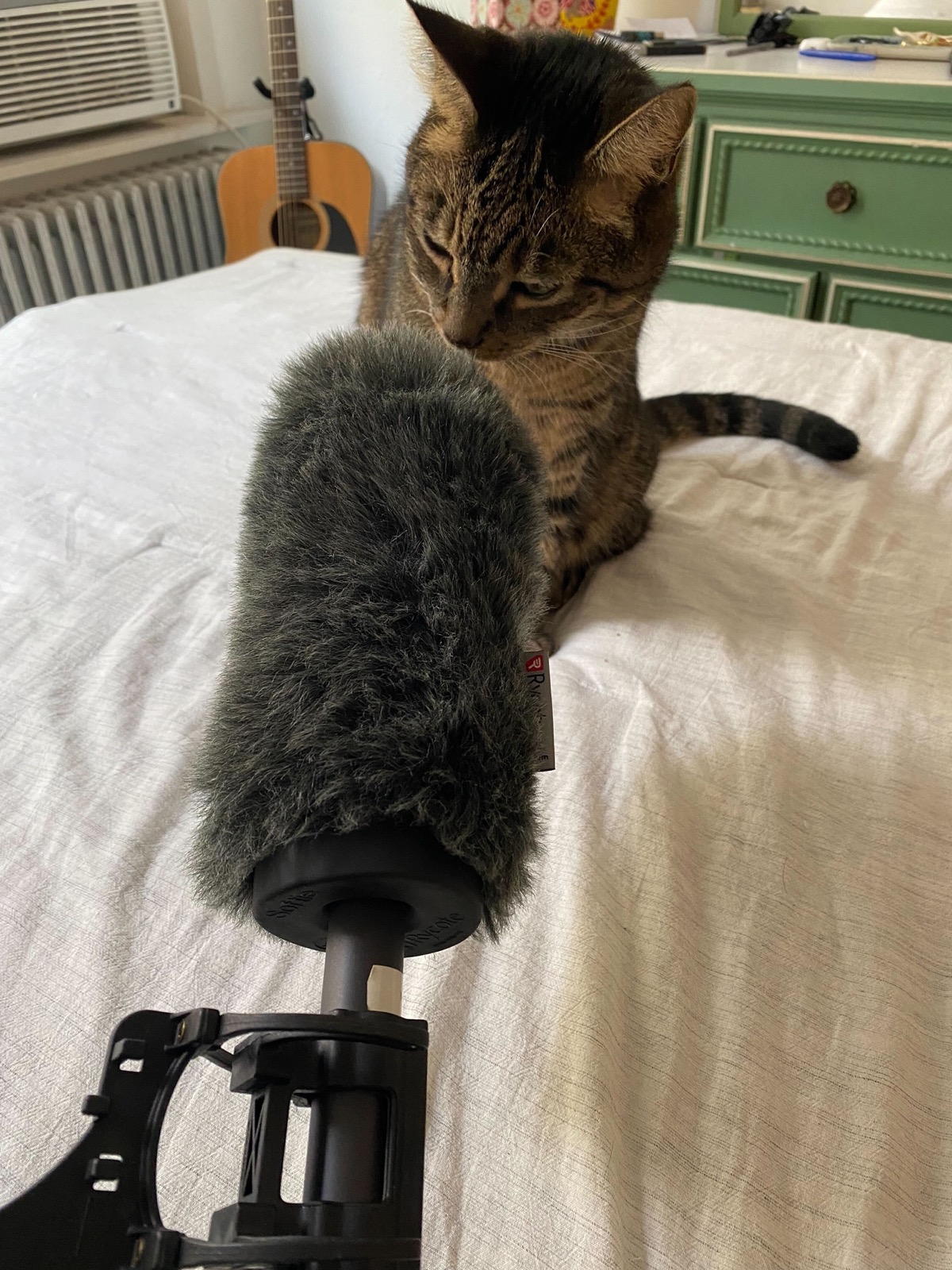Why Do Cats Purr? An Investigation Into A Purr-fect Mystery
12:17 minutes

 Science Friday recently received a voicemail from a listener named Violet from Maui, Hawai’i, who wanted to know: Why do cats purr?
Science Friday recently received a voicemail from a listener named Violet from Maui, Hawai’i, who wanted to know: Why do cats purr?
We wanted to see what other cat lovers knew about cat purring. So we sent our talented SciFri colleagues Diana Montano and Kyle Marian Viterbo to the Meow Parlor, a cat cafe in New York City to find out.
Guest host Katherine Wu, who recently wrote about why cats purr for The Atlantic, also talks with Robert Eklund, professor of language, culture, and phonetics at Linköping University in Linköping, Sweden. He explains what we do and don’t know about how and why cats purr.

Invest in quality science journalism by making a donation to Science Friday.
Dr. Robert Eklund is a professor of Language, Culture and Phonetics at Linköping University in Linköping, Sweden.
KATHERINE WU: This is Science Friday. I’m Katherine Wu.
KATHLEEN DAVIS: And I’m Kathleen Davis. A few months ago, we got a voicemail from a listener, asking a very important scientific question.
YOUNG LISTENER: Why is the reason cats purr? I’m just very interested with that because my eight-month-old cat is like always purring. I wonder why they purr.
KATHERINE WU: Wow. What a great question. And today, we’re going to try to get to the bottom of it. Last month, I actually looked into why cats purr for a piece in The Atlantic. I was inspired by my own two cats, Calvin and Hobbes. When I have bad insomnia, their purrs are pretty much one of the only things that can lull me to sleep.
[CATS PURRING]
KATHLEEN DAVIS: Wow. So soothing.
[CATS PURRING]
Katie. Katie! Katie! Wake up! Wake up!
KATHERINE WU: Oh, my gosh, Kathleen. I am so sorry. That just put me right to sleep. Oh, all right. I’m here.
Kathleen, you’re a cat person, too, right? Have you thought about why your cat, Miguel, purrs?
KATHLEEN DAVIS: Yes, I have thought about why my cat purrs. He purrs when he’s happy, but he also purrs when he’s hungry and when he thinks he’s about to get food. So I have a lot of questions about what’s actually going on in his little body when he purrs. But, I mean, listen to these good vibrations.
[CATS PURRING]
So we wanted to see what other cat lovers knew about cat purring. We sent our talented SciFri colleagues, Diana Montano and Kyle Marian Viterbo, to the Meow Parlor, a cat cafe in New York City, to find out.
SPEAKER: I have heard that cats purr when they are happy. I also know that sometimes they do it when they’re unhappy, because it soothes them.
[CATS PURRING]
SPEAKER: I know that they purr if they’re like semi-satisfied or happy. But then I also know there’s a morbid one, where, like, if they’re about to die, they also purr.
SPEAKER: I mean, I have a friend whose cat, Haku, is constantly purring, like every second. Sometimes, if you’re quiet at night, you’ll hear him purring like as he’s walking down the hall. He’s so loud.
[CATS PURRING]
SPEAKER: I would say that the kittens purr a lot more. I notice a lot more purring from just like, you touch them, and they’re like, oh, my god. And the adults are like, OK, what are you doing? I could not tell you scientifically why that is happening, though.
INTERVIEWER: What an emotional roller coaster, too. There’s happy theories. There’s kind of not so happy theories. I feel like it’s time to dig into the science. So joining me now to talk more about what we do and don’t know about why and how cats purr is my guest. Robert Ecklund is a professor of Language, Culture, and Phonetics at Linkoping University, in Linkoping Sweden.
Dr. Ecklund, welcome to Science Friday.
ROBERT ECKLUND: Thank you. I’m so happy to be here.
INTERVIEWER: Yeah, it’s great to have you. So let’s start with the basics of purring. What exactly is a purr? And how is it different from another cat vocalization, like a meow?
ROBERT ECKLUND: If you use a stringent definition, it should be a continuous alternating egressive and ingressive sound produced by the lungs. And that means that the lungs push and draw in and out of the lungs and through the voice box.
INTERVIEWER: It sounds like purring is the ability to vibrate one’s vocal cords while both inhaling and exhaling.
ROBERT ECKLUND: Yeah. And to be exact, inhaling and exhaling using the lungs. So if you listen to purring, and you try to mimic it, it would be like– [PURRING SOUNDS]– where every second phase is done by exhalation and every second phase is done by inhalation.
Not all cats purr. Lions, tigers, leopards, and jaguars definitely don’t purr, but they can roar instead. And the opposite goes for the cats that purr. They can purr, but they can’t roar.
Not only cats purr, it’s been proven that genets purr, polecats purr, and possibly even the fossa, which is endemic to Madagascar. How come some of them don’t purr, like the four big ones I mentioned before, and the smaller ones all purr as far as we know?
And already in 1833, the very famous zoologist, or biologist, Richard Owens, he noticed that if you dissect cat voice boxes, you will find a difference. One of the structures in the voice box is made out of cartilage in the bigger cats, the roaring cats, whereas that same structure is ossified, it’s made out of bone, in the smaller cats that do purr. And he made that the explanation. And then other zoologists sort of draw the conclusion.
So if you have a cartilage, you can stretch the voice box. And if you can stretch it, you can roar. And if it’s solid, as in bone, you can’t stretch your voice box. And that results in the drum roll, as it were, that is called purring.
The thing is that it’s agreed right now that that can’t be at least not the only explanation. There are other differences as well.
INTERVIEWER: And so when we’re talking about the animals that can do the bona fide purr, I understand that cheetahs are among them, among the big cats that are able to do this. And you’ve recorded this, right?
ROBERT ECKLUND: So I did a small paper. I recorded the cheetah, the huge very kind cheetah, Caine. It’s one of the biggest cats I’ve seen.
[CHEETAH PURRING]
And then I recorded my girlfriend’s tiny little domestic cat, and wrote a paper, with Gustav Peters. What was funny is that, although the little cat weighed around 7 pounds and the cheetah weighed in at 180 pounds, the frequency, the tone, where purring was produced, was about the same. If you translate it to a key on the piano, it would be basically the same keys, despite this huge difference in size.
INTERVIEWER: I want to get to the big central question here. Why do cats purr? Most of us who have been around a purring cat, I think, have this connection between purring and happiness. But that’s not always the case, right?
ROBERT ECKLUND: And that is actually one of the things that is established. Cats can purr also when they are in pain, when they give birth, when they are about to die, and when they are very nervous or uncomfortable.
Cheetahs, who are really prominent purrers– they purr like crazy– at least if they are tame– wild cheetahs we don’t know because they are out in the wild. And I’ve asked people working with cheetahs and who have bred cheetahs for decades, and they have never heard a cheetah purr for any other reason than being very happy and content.
INTERVIEWER: Wow.
ROBERT ECKLUND: So why do domestic cats purr? For different reasons or at least in different contexts. Vocalizing is some kind of signaling to the outer world what’s going on, and either within your species or to another species. And purring in this case could be labeled as some kind of signaling to the outer world that, leave me alone. I want things to stay the way they are. And, above all, I don’t pose a threat to anyone.
If you’re happy and content, if you’re afraid, if you’re dying, if you are giving birth, you definitely don’t pose a threat to your surrounding fellow cats or other animals.
INTERVIEWER: And so part of this cat-human connection, I think a lot of people have in recent years been floating around this very interesting claim that cat purring might have special healing powers, either for the cats that are doing the purring or other animals around them– maybe even us. Have you heard about this? And is there any evidence to back up this magic healing power?
ROBERT ECKLUND: No, there is no scientific evidence for it. On the other hand, it is known that cats are beneficial to your health, at least. Having a purring cat on your chest definitely does good things for your own health.
The specific claim here, which was made around 20 years ago, was that purring helped healing fractures. It was a suggestion. It had never been tested, neither by the author, nor by anyone else. And the problem here is that it would be, well, a problem.
Actually, happily, it would be very hard to be allowed to perform such an experiment. Because how would you do it? You would take two cats– preferably siblings– you would break their bones. And then you would prevent one cat from purring and get the other cat to purr like crazy, and then check whether the fractures heal faster in the purring cat. And of course, you can’t do that. No ethical committee in the world would approve such an experiment.
And the idea, as such, is not stupid. It sort of makes sense. And NASA did some vibration studies. Because astronauts, being in space for a long time, they lose both muscle tissue and also bone structure. So they tried vibration plates and stuff like that to see whether that would be a way of preventing this to happen. And I never saw anything published, and it just faded away without anything being published, which I take as some kind of evidence that they didn’t get the results they wanted.
INTERVIEWER: All right. So I mean, you’ve just given a pretty key example of why it is pretty tough to study purring in general, its effects, and also I imagine the mechanics are really hard to test. Why is it so hard to study purring? I mean, cats do it all the time. Why can’t we just see what’s going on?
ROBERT ECKLUND: Exactly when I did this recording of Caine and wrote my comparison between the domestic cat and Caine, I was affiliated with the Karolinska Institute, in Stockholm, doing fMRI analysis of human brains. And I spoke to the professor there, who is one of Sweden’s most famous scientists. And we discussed this. And he said, yeah, let’s put the cheetah in an MRI bore and see how he does it.
And the thing is– you already guessed it– is that it would be impossible to get a cat to purr in one of these really loud, scary machines. And that’s the thing. If it were humans who purred, we would know how we do it. Because you would take students, offer them a cinema ticket or something like that, and put them in the bore and ask them to purr, and they would do it.
With animals in general, and with cats in particular, you can’t tell them what to do, and when.
INTERVIEWER: Right. Oh, this is seemingly the eternal problem with cats. So interesting, but so hard to study. My cats certainly don’t do anything on command.
ROBERT ECKLUND: And that’s sort of the definition.
INTERVIEWER: Right. Well, there is clearly so much more to learn about cat purring, and I look forward to your work, and others’ work. I’ll be following all of this closely.
I think that is all the time we have. But thank you so much, Dr. Ecklund, for joining us today.
ROBERT ECKLUND: It’s always a pleasure to talk about cats.
INTERVIEWER: Absolutely. I fully agree with that. Robert Ecklund, is a professor of Language, Culture, and Phonetics at Linkoping University, in Sweden.
If you or your kids have a science question that’s been nagging at you, we want to know. Share it with us on social media, or go to sciencefriday.com/contacts, to get in touch. We’ll try our best to answer it on the show.
Copyright © 2022 Science Friday Initiative. All rights reserved. Science Friday transcripts are produced on a tight deadline by 3Play Media. Fidelity to the original aired/published audio or video file might vary, and text might be updated or amended in the future. For the authoritative record of Science Friday’s programming, please visit the original aired/published recording. For terms of use and more information, visit our policies pages at http://www.sciencefriday.com/about/policies/.
Shoshannah Buxbaum is a producer for Science Friday. She’s particularly drawn to stories about health, psychology, and the environment. She’s a proud New Jersey native and will happily share her opinions on why the state is deserving of a little more love.
Diana Plasker was the Senior Manager of Experiences at Science Friday, where she created live events, programs and partnerships to delight and engage audiences in the world of science.
Kyle Marian Viterbo is a community manager at Science Friday. She loves sharing hilarious stories about human evolution, hidden museum collections, and the many ways Indiana Jones is a terrible archaeologist.
Katherine Wu is a staff writer at The Atlantic based in Boston, Massachusetts.